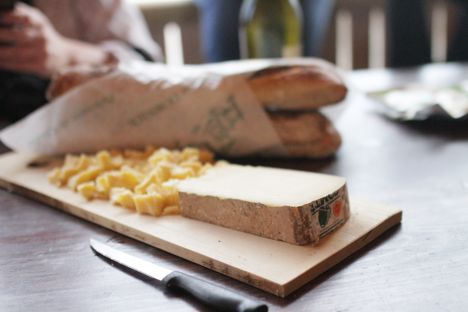
Comté country
Steeped in culture and tradition, the French village of Jura Massif is home to the iconic Comté cheese. Felicity Spector recently visited the Jura mountains to discover the secrets, heritage, and of course, the taste of Comté.
Comté country
Steeped in culture and tradition, the French village of Jura Massif is home to the iconic Comté cheese. Felicity Spector recently visited the Jura mountains to discover the secrets, heritage, and of course, the taste of Comté.
Respect. It's a word you hear a lot, high up in the Jura mountains, in the family farms and the small dairies and the great, dark underground caverns lined with more cheese than you could ever imagine. This is Comté country, heart of a cheese-making tradition that goes back more than a thousand years, where the watchword is respect. For the environment, for the terroir, for the ingredients, and the process: there is no stamp of big business or agri-commerce here.
At the fruitiere de Bouverans, we meet the ebullient and ever so slightly eccentric 'Tas', who sports a cowboy hat and an attitude to match, but whose dedication to his craft is second to none. Comté must be made from the milk of just two breeds of cattle - Montbeliarde and Simmental: a truck of which arrives twice a day from local farms, then is poured into giant vats which churn and hum, huge rakes cutting the curds as they form. ‘It's all done by touch and by hand’ says Tas. ‘We use only raw milk - and it's different every day, so you need to know what you're doing.’ And with cheesemaking in his family for over a hundred years, he certainly does.
There's no rushing this process: ‘No turbulence! It must go very gently!’ says Tas. As the curds steadily get smaller and firmer, workers start siphoning off the whey and pressing the cheese into gigantic moulds. From here, they'll be dipped in brine and rubbed with salt, the rinds stamped with a quality mark and a unique number to show not just the date, but precisely where they've been made.
And provenance is what it's all about. We trek up a steep hillside, through the long grass and the purple clover flowers, to a high ridge where a group of cattle are gathered in search of a cooler breeze. The flavour of their milk will depend entirely on this grass, the flowers, the herbs. No two cheeses will taste entirely the same: we try a few, made by different dairies and at different times of the year. There's a whole kaleidoscope of flavours, from roasted and nutty, to notes of freshly cut grass. Another variant, the paler winter cheese, is made from the milk of cows who've been eating supplies of straw.
The ageing cellars is where the magic really happens. At Marcel Petit, housed in a former military fort with 3 metre thick walls, the air is kept in a state of humid chill and the endless shelves of cheeses go on for miles. Here, in the ammonia-spiked gloaming, the cellar masters are constantly at work, turning the giant rounds, plunging in cheese irons to test the quality, tasting and grading and tasting again. Holding onto that precious PDO status, they tell us, is like keeping a third Michelin star. Everything is entirely natural: just the atmosphere inside the caves, and microbiology does the rest. ’Do a bad job here’, says 35 year veteran Claude, ‘and you'll never get a good cheese.’
And what cheese! From the giant slabs we're constantly invited to taste - to some of the Jura region's most special restaurants - Comté is everywhere. A vast fondue at the brilliant La Petite Echelle, rich with Jura wine and foraged woodruff, followed by the biggest rosti you could ever imagine, the size of the table, topped with sliced sausage and shavings of cheese.
Refined dining at Le Bon Acceuil, where chef Marc Faivre fashioned roasted maize flour into tubes of gnocchi, before draping it with gently melting slices of aged Comté. There were cheese sablé biscuits too, melting into rich butteriness. And at l'Atelier du Chef cookery school, we learned the art of soufflé making, whisking clouds of egg white into a roux, before adding copious amounts of Comté, chopped morels and walnuts.
Every flavour was truly unique. You can taste the history here, the landscape, the care that goes into the whole process, from the farms to the caves, amid the hillside flowers and the clear mountain air. Respect. It's a word you hear a lot - and in Comté country, it really shows.


